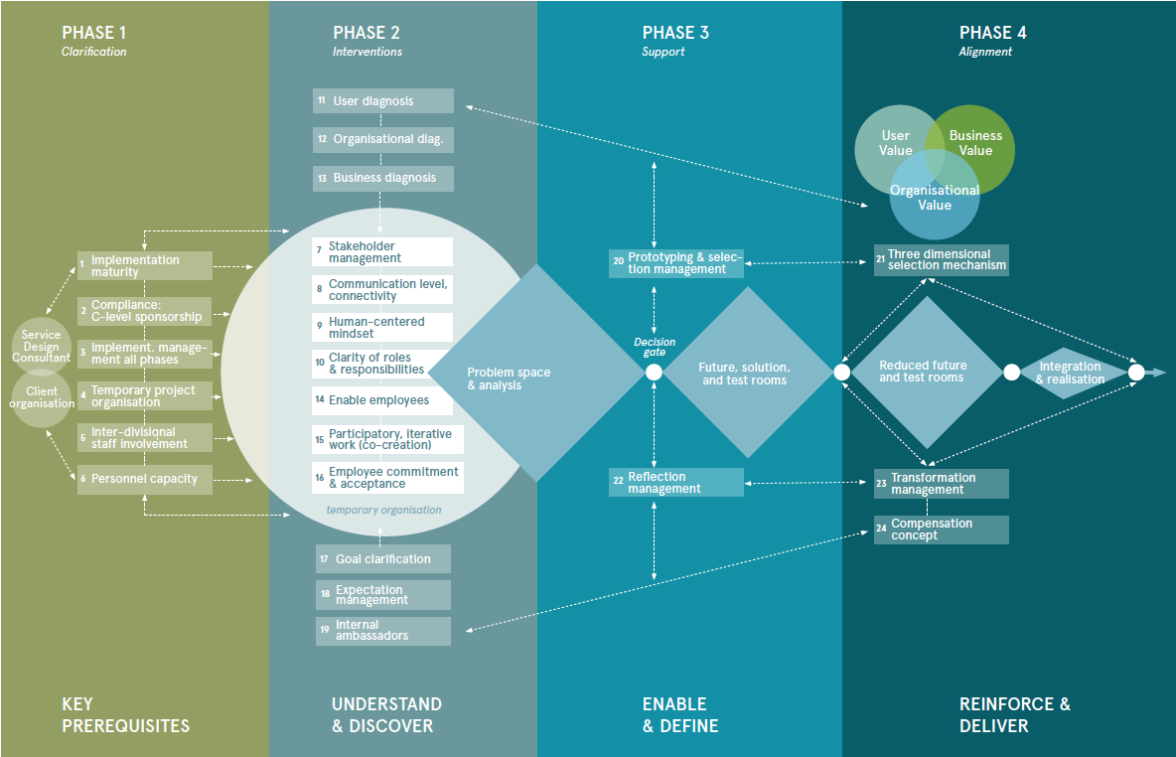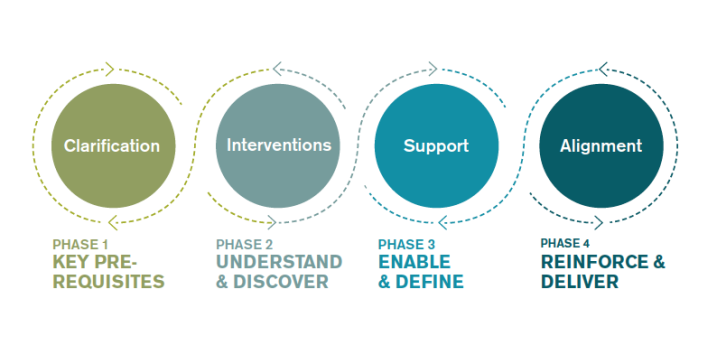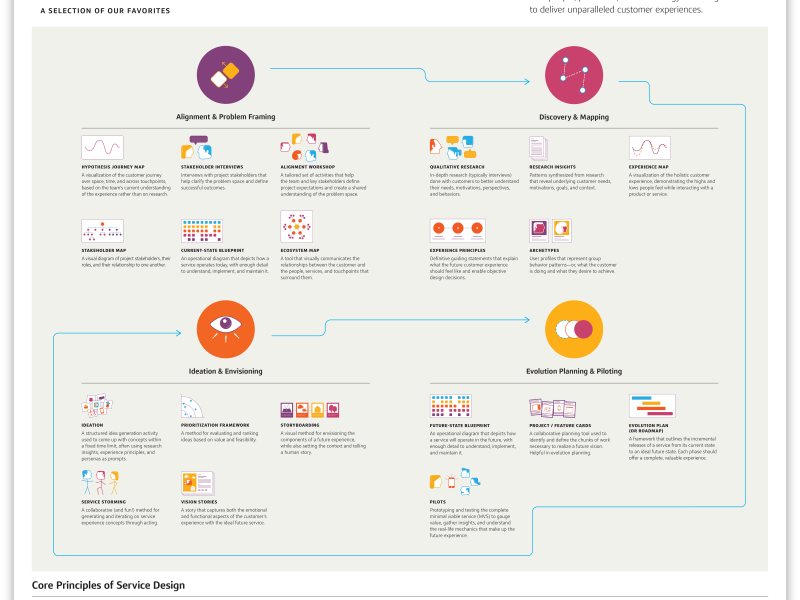A Blueprint for Successful Implementation
In an era where customer experience reigns supreme, service design has emerged as a critical discipline for organizations aiming to innovate and stay competitive. Yet, despite its potential, many service design projects falter during implementation.
Why do brilliantly conceived concepts fail to take root in daily operations? A three-year international study led by Tina Weisser sought answers, culminating in the KUER model—a systemic framework designed to bridge the gap between strategy and execution.
This article explores the KUER model, its four phases, 24 influencing factors, and actionable lessons for service designers and organizations. By integrating insights from organizational development, systemic thinking, and hands-on case studies, we’ll unpack how to turn service design visions into tangible outcomes.
Why Service Design Projects Fail: The Implementation Gap
Research reveals that only 4% of service design methods focus on implementation, leaving a glaring gap between concept and delivery (Martins, 2012). This oversight often results in resistance, misalignment, or abandoned projects. Common barriers include:
- Lack of C-level sponsorship or implementation maturity on the client side.
- Insufficient understanding of organizational culture and system dynamics.
- Service designers’ limited expertise in managing systemic change.
The KUER model addresses these challenges by emphasizing hygiene factors, iterative processes, and systemic diagnostics. Let’s dive into its structure.
The KUER Model: Four Phases for Sustainable Implementation

The KUER model—Key Prerequisites, Understand & Discover, Enable & Define, Reinforce & Deliver—provides a non-linear, adaptive roadmap for implementation. Here’s how each phase unfolds:
Phase 1: Clarification (Key Prerequisites)
“Begin with the end in mind.”
Before launching a project, six hygiene factors must be secured:
- Implementation maturity: Does the client have the infrastructure to sustain change?
- C-level sponsorship: Is leadership committed to the initiative?
- Implementation management: Are roles and responsibilities defined?
- Temporary project organization: Is a “safe space” for co-creation established?
- Inter-divisional staff involvement: Are cross-functional teams engaged?
- Personnel capacity: Do teams have bandwidth for the project?
Neglecting these factors risks derailing projects early. For example, BMW Group’s successful i Ventures mobility solutions relied on executive buy-in and dedicated innovation labs (BMW Group, 2023).
Phase 2: Understand & Discover
“Diagnose before you prescribe.”
This phase involves deep organizational diagnostics:
- User Research: Uncover pain points through journey mapping and ethnographic studies.
- Stakeholder Analysis: Map power dynamics and resistance risks.
- Systemic Diagnostics: Apply Frederic Vester’s sensitivity analysis to assess interdependencies (Vester, 2007).
For instance, IDEO’s work with the NHS leveraged co-creation workshops to align stakeholders on mental health service redesign (IDEO, 2020).
Key Insight:
“Client organizations are living systems—not machines. They resist linear control.”
Phase 3: Enable & Define
“Prototype, test, repeat.”
Here, solutions are iterated via:
- Rapid Prototyping: Test concepts with users and employees.
- Three-Dimensional Selection: Evaluate ideas based on user desirability, technical feasibility, and business viability.
- Storytelling: Use narratives to convey the “meaning” of changes, reducing uncertainty.
Livework’s collaboration with E.ON utilized storytelling to translate smart grid concepts into relatable employee narratives (Livework, 2021).
Phase 4: Reinforce & Deliver
“Anchor change in daily routines.”
The final phase focuses on integration:
- Measurement: Track KPIs like ROI, user satisfaction, and efficiency.
- Cultural Anchoring: Embed new practices through training and governance models.
- Feedback Loops: Continuously refine based on employee and user input.
Capgemini’s Agile Change Management framework highlights the importance of iterative feedback in sustaining digital transformations (Capgemini, 2022).
12 Lessons for Service Designers
The study distilled actionable insights for practitioners:
- Hygiene Factors Are Non-Negotiable
Without C-suite buy-in or cross-departmental teams, even the best concepts fail. - Start Implementation on Day One
Use iterative contracting to align expectations and resources early (Mager, 2018). - Respect Organizational Context
Diagnose culture and history—like how OSB-I Consulting adapted strategies for a 100-year-old manufacturing client. - Work With System Logic, Not Against It
Prototypes and co-creation reduce resistance by making abstract ideas tangible. - Bridge the Closeness-Distance Dilemma
Collaborate closely but maintain objectivity—a balance IDEO achieves through “T-shaped” teams. - Prepare for Disciplinary Borders
Ensure handoffs are seamless to avoid “corporate entertainment” pitfalls.
The Future of Service Design: Systemic Thinking & Partnerships
The KUER model underscores that service designers must evolve beyond UX expertise. Skills in systemic organizational consulting and partnerships with management consultancies (e.g., Capgemini, Etventure) are critical. As Tina Weisser notes:
“Organizations can only change themselves. Our role is to guide, not dictate.”
By adopting KUER, teams can transform implementation from a gamble into a science—one grounded in empathy, adaptability, and systemic rigor.
Original post from Tina Weisse (LINK)
References & Further Reading
- Martins, R. (2012). Design for Next. EAD 12 Rome.
- Vester, F. (2007). The Art of Interconnected Thinking. Springer.
- BMW Group. (2023). Innovation Labs. BMW Group.
- IDEO. (2020). NHS Mental Health Case Study. IDEO.
- Service Design Network. Case Studies. SDN.
- Mager, B. (2018). Service Design Conference Keynote. SDC.


